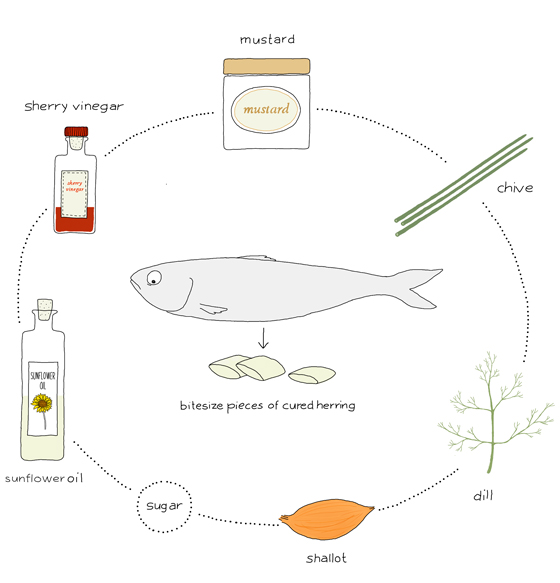This year I will be celebrating midsummer here in NY. Midsummer is the day when Swedes like me celebrate the longest and brightest day of the year. We eat plenty of herring, new potatoes (that you buy freshly picked and dirty), aged cheese on “knäckebröd“, drink aquavit and sing songs. The dessert is always strawberries which are often eaten plain with just a little sugar and cream (either whipped or mixed with milk.) Some make creamy strawberry cakes while I serve mine with dark chocolate cake and whipped cream.
For practical reasons the midsummer holiday is always on the Friday closest to the actual summer solstice day which this year will be on Friday the 22nd of June.
The traditional herring you eat for midsummer is Matjes. It’s an excellent herring typically spiced with sugar, allspice, cinnamon and cloves. Traditionally you eat this type of herring with sour cream topped with chopped chives and new potatoes & fresh dill. I love this meal so much that I keep eating it throughout the whole summer.
Other common flavors are mustard, onion, lemon or dill herring. More rare or rather unexpected flavors are tomato, garlic or curry herring (not my cup of tea though). You can find these different types at any supermarket in Sweden or more homemade styles in most Swedish fishmongers.
If you can get hold of fresh herring, the best experience is to cure and flavor herring yourself. This can be a tough task if you are outside Scandinavia. In New York City I have only seen fresh herring a couples of times. In the city it’s possible to find simple cured herring in vinegar. You don’t really need to do anything if you find this kind of herring but with just a few simple additions like mustard and dill you will raise this fish to another level (see below).
the cure
(if you can get hold of fresh fish otherwise skip this part)
- about 1 lb filets of fresh herring*
- ½ cup white vinegar (6%)**
- 2/3 cup water
- 2 tablespoon sugar
- 2 tablespoon salt
Rinse the herring in cold water. If you like you can skin the herring but I normally do that after the cure as it gets off easier then. Mix the white vinegar together with the salt and the sugar. When the sugar and salt are totally dissolved in the liquid add the water. Place the herring in a bowl and pour the vinegar mixture over. Set aside in the fridge for about 24 hours. Stir in between to make sure that all fillets gets properly cured. Its done when all fillets have become white in color.
Let the fillets drain properly in a strainer while you prepare the sauce. Remove the skin with your fingers or use a knife to peel it off. Cut the fillets with a scissor into bite size pieces.
mustard herring
- about one lb cured herring(as above or get simple herring in vinegar. Only use the herring pieces, removing all liquid, onion, etc.)
- 3 tablespoons sweet mustard
- one tablespoon dijon mustard
- one tablespoon brown sugar
- one teaspoon sherry vinegar (apple cider vinegar works as well)
- 50 ml sunflower oil (or other neutral vegetable oil)
- ½ cup dill
- one shallot
for decoration
chopped chives
Mix together mustard, sherry vinegar and sugar. Add carefully the oil drop by drop while stirring. Chop the shallot and dill finely and add it to the sauce. Season with salt and freshly milled black pepper. Place the herring pieces into the sauce and stir carefully around so the sauce gets around the fish evenly. Let the fish rest for a couple of hours, preferably 24 hours but I can never wait that long. Before serving chop the chives into 1/4” pieces and sprinkle on top. Serve the herring with new potatoes or just on dark rye bread with sliced boiled eggs. Enjoy!
* It’s not impossible to fillet the fish yourself but you need some practice. This is one way: Cut off the head and tail. Open up the stomach with a small knife (or even your fingers) to take out the innards. Make it as clean as possible. Now comes the tricky part where you use your thumbs to loosen the backbones by pressing your thumb under it. When it starts to loosen grab the top of the backbone and pull it off. You now have both fillets connected together. Remove the fins with a scissor and rinse the fillet in cold water. You will get a hang of it after some practice. If you think this is too messy, just ask your fishmonger to do it for you.
** If you only find 5% white vinegar you should use a little less water.
Before buying any fish check with Seafood Watch for the most sustainable options.
Thei article was originally published at EcoSalon on 19 June 2012.


